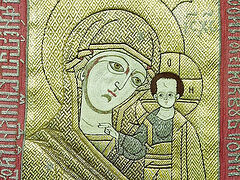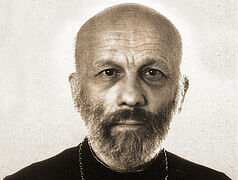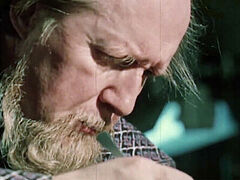As early as in the 1930s, the Soviet system had been firmly established and would last awhile, and it was seen by then as the only possible way of life. The Church and faith, in general, were perceived as anachronisms, things having no connection whatsoever with the present, and much less with the future life of the country. Sure enough, the Church was still there, though the believers were persecuted in one way or another, depending on the time of persecution. Because even I, who started school in 1982, remember how our middle school teacher berated a girl on a the mere suspicion she wore a cross on the chain around her neck. Everyone seemed to assume that the Church existed in another, parallel, dimension, and almost no one knew about it…
Even the icons or church paintings were perceived by wider society as beautiful artistic monuments of olden days, and people used to talk about the beauty of lines and color combinations, leaving out any theological meaning (this is putting aside the scientific studies, because what we are talking here is general perception).
Our culture is connected with Orthodoxy in a huge way, and religious images, storylines, and allusions repeatedly appear in the works of art
However, our culture is connected with Orthodoxy on a massive scale, and religious images, storylines, and allusions repeatedly appear in our works of art. This was especially true for the second half of the twentieth century. Thus, in the movie, “I'm walking through Moscow” (1964) directed by George Danyeli at the time of cultural “thaw,” the Church is shown simply as part of the life of a large city, sans caricature or grotesqueness. Sure, only elderly ladies prayed inside the church, plus it all seemed too odd to the eye of the Soviet youngsters, but still… We should also remember that, despite it being the “thaw,” Nikita Khrushchev promised in 1961 that Soviet citizens would soon see on TV the “last priest” of their country.
Or, take another movie made by Vasily Shukshin ten years later—“Red Kalinaberry.” There are many scenes in this movie where a church building appears in the frame—and what’s important, this happes at the movie’s most decisive moments. It begins practically at the very beginning, when the main character is taking a ride on a hydrofoil that was moving past a destroyed and flooded church. Or, when he was running away from the thieves’ den along the riverbank and another church was seen reflected in the water. Or, in the next-to-last frame, after Egor’s death—we see the surface of water and a flooded church... It turns out that church and water are frequently put together here. Water is a symbol of purification, and on the feast of Theophany people immerse thrice in water—as if dying and then being born anew. The main character in this movie is also born anew. Egor's repentance—the most powerful scene in the movie—also takes place near a church. “Lord, forgive me if you can! I can’t go on anymore!” Egor shouts in his prayer in a movie that came out in theaters in 1974.
Generally speaking, we can find a great number of such examples in other famous Soviet movies…
If we take fine art, the church theme is conveyed to us there through architectural forms. In 1943, artist Victor Tsiplakov is travelling to Smolensk, which is still lying in ruins as it had just recently been liberated from fascists. His painting is called simply “Smolensk,” except that the artist doesn’t paint the shells of destroyed buildings. Instead he depicts the Dormition Cathedral, towering tall above everything around it—the symbol of a major force that restrained and helped us to stand firm; a symbol of life. But it wasn’t only the architecture that Tsiplakov witnessed—he also painted a study, also dated 1943, called “Divine Service in the Dormition Cathedral in Smolensk.” It actually depicts the inner life of the church (the cathedral was returned to the Church in 1941). Women in headscarves, standing in front of the iconostasis, which glitters with Baroque gold—it is they who carried and preserved the faith at the time when this cathedral was closed in order to house an anti-religion museum. It was also owing to their prayers that we earned our Victory… So, the realist painter records and paints them, because he is thinking of us, the future generations, who would look at his art eighty-one years later.
 “Smolensk.” Artist Victor Tsiplakov. 1943.
“Smolensk.” Artist Victor Tsiplakov. 1943.
 “Services in the Dormition Cathedral in Smolensk.” Artist Victor Tsiplakov
“Services in the Dormition Cathedral in Smolensk.” Artist Victor Tsiplakov
For Arkady Plastov, church was a part of life despite the fact that he also had rather warm relationship with the authorities. He earned the title of “People’s Artist of the USSR”, and became a laureate of the State Lenin and Stalin Prizes. In actual fact, he wasn’t trying to establish any relationship with the authorities as such, but he simply worked hard by focusing primarily on his art and the people who lived near to him, including in his native village of Prislonikha. He remained a practicing Christian who attended services regularly. In 1950, he painted watercolors named “Kuliches” and “The Winter Feast. St. Nikolas” that show snippets of church life, which could not be talked about. And it wasn’t shown as something exotic, but as something well known, truly meaningful and joyful.
Sergei Gerasimov, the People’s Artist of the USSR, was another quite successful Soviet artist who headed the Surikov Art Institute for five years. He would also use the subject of religion in his art from a perspective of someone who was brought up in a religious family, whose Christian upbringing wasn’t purged away under the pressure of future historical events. Here is, for example, his study “At Church” dated 1945, where the artist did not simply paint the interior of the St. Elijah Church that never closed down, but he depicted it during the divine service in the manner of Impressionists (Sergei Gerasimov was a student of Konstantin Korovin in his day). We can see in this work what the painter has observed and captured at a given point in time: the atmosphere of church space, the lights of the chandelier and candles at the candle stands, reflections on the gilded surfaces, a large crowd of the faithful… Again, we see the artistic rendering of the importance of the Church and its attendance by the faithful.
 “At Church.” Artist Sergei Gerasimov, 1945.
“At Church.” Artist Sergei Gerasimov, 1945.
For Nikolai Chernyshev, the mural artist, it was essential that during the 1920s he was a member of the “Makovets” society, the members of which agreed that art should be defined by spiritual and cultural traditions. It was at this time that he began studying the ancient Russian monumental art. He would later arrange his learning experience in his work called, “The Art of the Fresco in Ancient Rus: Materials for Study of Ancient Russian Frescoes” that was published by the “Art” publishing house in 1954.
 “At the artist’s studio.” Artist N.M.Chernyshev (1885–1973), 1967.
“At the artist’s studio.” Artist N.M.Chernyshev (1885–1973), 1967.
He often turned in his art to the theme of the old masters. Thus, in 1960 for example, he paints saints Andrey Rublev and Daniil Cherny twice. In one painting, the holy icon painters are depicted contemplation an icon, while in another, the artist pays more attention to their individual qualities, as if in a portrayal of each of their personalities. At the same time, the artist emphasizes what unites them—their ardent devotion to high Church art.
 “Daniil Cherny and Andrey Rublev— masters of Russian painting.” Artist Nikolai Mikhailovich Chernyshev, 1960s.
“Daniil Cherny and Andrey Rublev— masters of Russian painting.” Artist Nikolai Mikhailovich Chernyshev, 1960s.
 “Andrey Rublev and Daniil Cherny.” Artist Nikolai Mikhailovich Chernyshev, 1960.
“Andrey Rublev and Daniil Cherny.” Artist Nikolai Mikhailovich Chernyshev, 1960.
An important part of this work is the Hodegetria Icon of the Mother of God—pointing the Way every artist should be aware of at all times
“In the Artist’s Studio”, dated 1967, an illustrative still life by Nikolai Mikhailovich, shows us the artist’s tools—brushes, the mosaic splitting machine, and a newspaper. The latter is used there as proof that the painter works at a specific time, and there is no escape for him from the most pressing issues of the day; or, in modern terms, hot items on the political agenda. But the important part of this work is the Hodegetria Icon of the Mother of God, which takes most of the artistic space. It is larger than the tools and it towers over everything else, because it shows the Way the artist should be aware of at all times…
Ilya Glazunov’s “Russian Man” from 1967 also includes the icon of the Mother of God, but in this case it becomes a part of the realm of the painting’s main character. On the one hand, it is understood that the artist’s intention was to depict something truly sound and enduring that lies at the core of every Russian man. On the other hand, the image of a main character, his clothing and the samovar on the table, are perceived as symbols of a bygone era that no longer fit into the realities of modern life. So does the icon also become a part of the old realm, “a relic of the past,” along with the samovar and the embroidered towel…
 “Russian man.” Artist Ilya Glazunov. 1967.
“Russian man.” Artist Ilya Glazunov. 1967.
Victor Popkov, whose art is about the movement towards an even greater narrative depth, simply couldn’t do without images that had to do with faith in one way or another. In general, it is simply amazing how he, focusing on the most important and meaningful, was able to achieve the precise image and depth by cutting off the seemingly interesting and artistically impactful details that in reality stood in the way of observing the essential. Let’s look at his study of the work called “A Chapel of the North” and at the painting itself (1972). The study, beautiful and vibrant, shows the interior in great detail where the boy’s figure is lost inside the church space. As for the artwork itself, the artist keeps the images of only three angels, who immediately attract the viewer’s attention. It is a story about two worlds—the life in Heaven that unfolds inside the church, and the realm of our earthly, daily life. And the boy, looking inside the chapel from the outside world, actually peers beyond it and into the heavenly realm…
 “The Chapel of the North,” study. Artist: Victor Popkov
“The Chapel of the North,” study. Artist: Victor Popkov
 “The Chapel of the North.” Artist: Victor Popkov, 1972.
“The Chapel of the North.” Artist: Victor Popkov, 1972.
Certainly, landscapes by Soviet painters from the second half of the past century often include images of church architecture. Regardless of whether it is an urban or pastoral landscape, the churches add loftiness to the artistic space, making it meaningful and beautiful. We can find a great number of such examples: “Pskov. At dusk” by Sergei Osipov, 1958; “A Street in Nizhny Novgorod” by Mikhail Kaneyev, 1966; “Indian Summer. Evening in Kolomna”, by Mikhail Abakumov, 1981; “Tot’ma in the Fall,” 1997 (understandably, the times have changed, but Abakumov continues what he began doing in the Soviet times); “On native shores” by Pyotr Fomin, 1979 (it seems that a small church is lost among the endless landscape in this work; but no, the artist draws attention to it by making it not only an inseparable part of the landscape, but also a meaningful and significant element). The work by Alexey Zhabsky called, “Uglich. The Theophany Cathedral,” 1984, also catches one’s eye by bringing together the landscape, the church architecture, and still life.
 “Pskov. At dusk.” Artist Sergey Osipov, 1958
“Pskov. At dusk.” Artist Sergey Osipov, 1958
 “A Street in Novgorod the Great.” Artist Mikhail Kaneev, 1966
“A Street in Novgorod the Great.” Artist Mikhail Kaneev, 1966
 “Indian Summer. Evening in Kolomna” Artist Mikhail Abakumov, 1981
“Indian Summer. Evening in Kolomna” Artist Mikhail Abakumov, 1981
 “Tot’ma in the Fall.” Artist Mikhail Abakumov, 1997
“Tot’ma in the Fall.” Artist Mikhail Abakumov, 1997
 “Uglich. The Theophany Cathedral.” Artist Alexey Zhabsky, 1984
“Uglich. The Theophany Cathedral.” Artist Alexey Zhabsky, 1984
Mainstream Russian art couldn’t get by without motifs and imagery connected with Orthodoxy
Everything mentioned above is small portion of examples of artists of the previous century who worked in the atheistic state, but who one way or another came up with religious subjects and motifs. It should also be noted that only officially accepted artists have been mentioned here; there were also underground artists. Some of them genuinely and deeply expressed their spiritual quest in their art, while others resorted to religious realities of the persecuted Church only as a sign of their opposition to the social system. Moreover, we have not even mentioned Biblical themes in art, but the Soviet artists used them as well…
Serious Russian fine art often simply couldn’t do without this or that motif and image connected with Orthodoxy, and we are not speaking here about personal beliefs or the level of the artist’s involvement in church life (however, it is important at times, if we try to understand the artist’s body of work). For how can we attempt to deal with the innermost matters of objective reality or sing odes to the beauty of central Russia and the Russian North, yet ignore our Christian culture?



